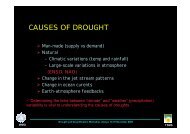training course on weather radar systems - RTC, Regional Training ...
training course on weather radar systems - RTC, Regional Training ...
training course on weather radar systems - RTC, Regional Training ...
- No tags were found...
Create successful ePaper yourself
Turn your PDF publications into a flip-book with our unique Google optimized e-Paper software.
MODULE A- INTRODUCTION TO RADAR<br />
polarizati<strong>on</strong>s. Although there are many different ways to mix the horiz<strong>on</strong>tal and vertical pulses<br />
together into a transmissi<strong>on</strong> scheme, the most comm<strong>on</strong> method is to alternate between horiz<strong>on</strong>tal<br />
and vertical polarizati<strong>on</strong>s with each successive pulse. That is, first horiz<strong>on</strong>tal, then vertical, then<br />
horiz<strong>on</strong>tal, then vertical, etc. And, of <str<strong>on</strong>g>course</str<strong>on</strong>g>, after each transmitted pulse there is a short listening<br />
period during which the <strong>radar</strong> receives and interprets reflected signals from the cloud.<br />
Since polarimetric <strong>radar</strong>s transmit and receive two polarizati<strong>on</strong>s of radio waves, they are<br />
sometimes referred to as dual-polarizati<strong>on</strong> <strong>radar</strong>s. The difference between n<strong>on</strong>-polarimetric and<br />
polarimetric <strong>radar</strong>s is illustrated below:<br />
4.13. Terminal Doppler Weather Radars (TDWR)<br />
Terminal Doppler Weather Radars a member of <strong>weather</strong> <strong>radar</strong>s family used generally at the<br />
airports for supporting the aviati<strong>on</strong> safety. TDWRs have the capability of detecting wind<br />
parameters indicating c<strong>on</strong>nective microbursts, gust fr<strong>on</strong>ts, and wind shifts. It provides a new<br />
capability for the disseminati<strong>on</strong> of <strong>radar</strong> derived, real-time, and warnings and advisories. The<br />
characteristics of the TDWR make it well suited for additi<strong>on</strong>al applicati<strong>on</strong>s. Its narrow beam and<br />
aggressive ground clutter suppressi<strong>on</strong> algorithms provide excellent data <strong>on</strong> boundary layer<br />
reflectivity and winds – in particular the locati<strong>on</strong>s of thunderstorm outflow boundaries.<br />
Similarly, its narrow beam (0.5 deg) could be useful for detecti<strong>on</strong> of severe <strong>weather</strong> signatures<br />
(e.g., tornado vortices) with small azimuth extent.<br />
4.14. Wind Profilers<br />
Wind profilers are specifically designed to measure vertical profiles of horiz<strong>on</strong>tal wind speed<br />
and directi<strong>on</strong> from near the surface to above the tropopause.<br />
Obtaining wind profiles c<strong>on</strong>sistently to the tropopause in nearly all <strong>weather</strong> c<strong>on</strong>diti<strong>on</strong>s requires<br />
the use of a relatively l<strong>on</strong>g wavelength <strong>radar</strong>. 404 MHz Wind profilers are relatively low-power,<br />
highly sensitive clear-air <strong>radar</strong>s, operating at a wavelength of 74 centimeters. The <strong>radar</strong>s detect<br />
fluctuati<strong>on</strong>s in the atmospheric density, caused by turbulent mixing of volumes of air with<br />
slightly different temperature and moisture c<strong>on</strong>tent. The resulting fluctuati<strong>on</strong>s of the index of<br />
refracti<strong>on</strong> are used as a tracer of the mean wind in the clear air. Although referred to as clear-air<br />
TURKEY RADAR TRAINING 1.0 / ALANYA 2005 41
















